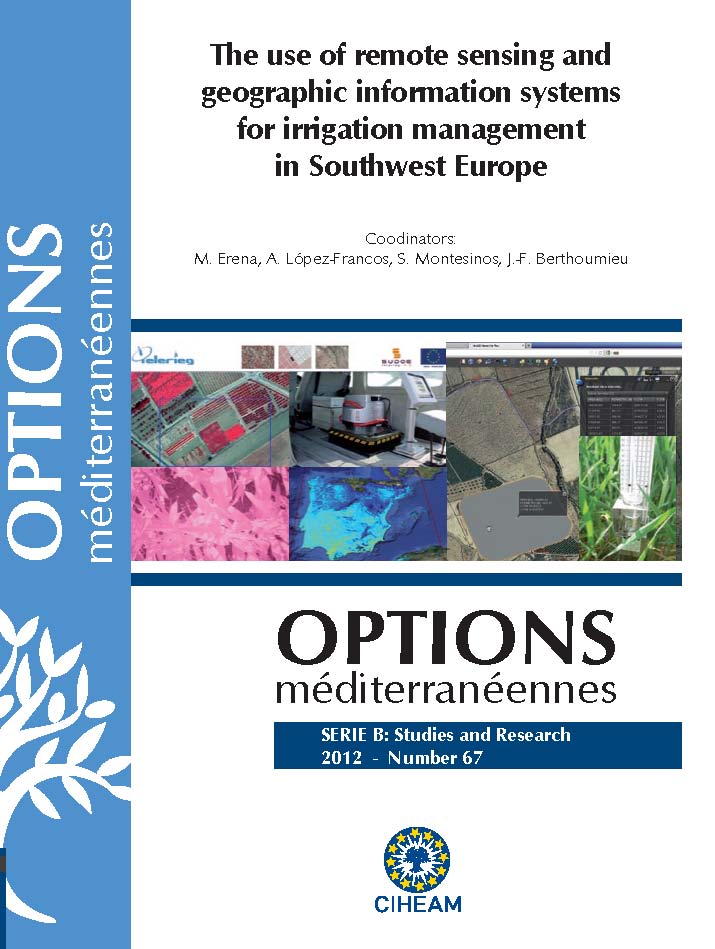| Article précédent | p. 131-137 | Article suivant |
The use of multispectral and thermal images as a tool for irrigation scheduling in vineyards
Multispectral and thermal imagery were studied to evaluate the relationship between grapevine water status and Plant Cell Density index (PCD) and Crop Water Stress index (CWSI). Grapevine water status was determined with a pressure chamber by measuring the leaf water potential (leaf) of 184 grapevines distributed homogeneously within a 11 ha vineyard. Image acquisitions and leaf measures were obtained simultaneously at noon. Results showed that PCD could be useful to discriminate well-watered zones in a vineyard. However the relationship between PCD vs leaf seemed to vary between different zones of the vineyard. This inconvenient did not exist with CWSI. The relationship between leaf and crop-air temperature differential was strong and presented a high coefficient of determination (r2 = 0.714; P < 0.0001) at noon. Accordingly, this methodology showed potential to be used as a tool for irrigation scheduling. Further studies should be directed to explore the convenience of CWSI measured at other moments of the day and the optimal thermal image resolution to obtain the best results.
Des images multispectrales et thermiques ont été étudiées pour évaluer la relation entre l'état hydrique de la vigne et le Plant Cell Density index (PCD) ainsi que le Crop Water Stress index (CWSI). L'état hydrique de la vigne est déterminé en mesurant le potentiel hydrique de la feuille ( leaf) avec une chambre à pression. Sur une vigne de 11 ha, 184 plantes distribuées régulièrement dans l'espace ont été étudiées. La prise des images et le potentiel hydrique ont été pris simultanément à midi. Les résultats ont montré que le PCD peut être utile pour discriminer les zones les mieux arrosées. Cependant la relation PCD vs leaf peut varier d'une zone de la vigne à une autre. Cet inconvénient n'existe pas avec le CWSI. En effet, la relation entre leaf et le différentiel de température entre l'air et la culture était très étroite et présentait un coefficient de détermination (r2=0,714 ; P<0,0001) très élevé à midi. Cette méthode a donc montré un potentiel comme outil de planification de l'irrigation pour la vigne. Cependant, pour obtenir de meilleurs résultats, les prochains travaux devront chercher à identifier le meilleur moment de la journée pour calculer le CWSI et définir la résolution optimale des images thermiques.
- [ Afficher ]
- [ Télécharger ]
- [ Exporter la citation ]
Vous pouvez télécharger la citation au format :
- [ Imprimer ]
-
Mots-clés
IMAGERIE, POTENTIEL HYDRIQUE FOLIAIRE, STRESS DU A LA SECHERESSE, VIGNECiter cet article
Bellvert J., Girona J. The use of multispectral and thermal images as a tool for irrigation scheduling in vineyards. In : Erena M. (coord.), López-Francos A. (coord.), Montesinos S. (coord.), Berthoumieu J.-P. (coord.). The use of remote sensing and geographic information systems for irrigation management in Southwest Europe. Zaragoza : CIHEAM / IMIDA / SUDOE Interreg IVB (EU-ERDF), 2012. p. 131-137. (Options Méditerranéennes : Série B. Etudes et Recherches; n. 67). http://om.ciheam.org/om/pdf/b67/00006603.pdf



